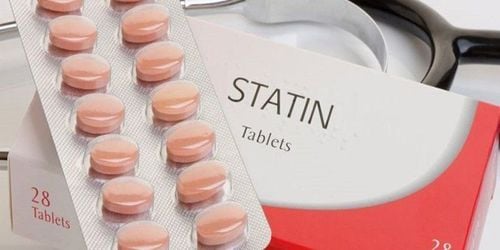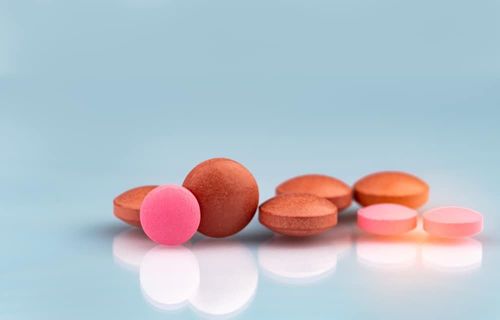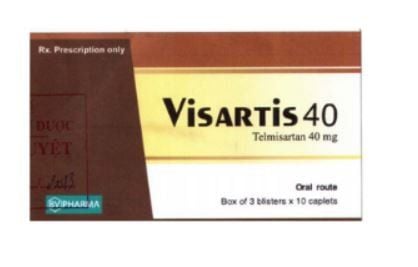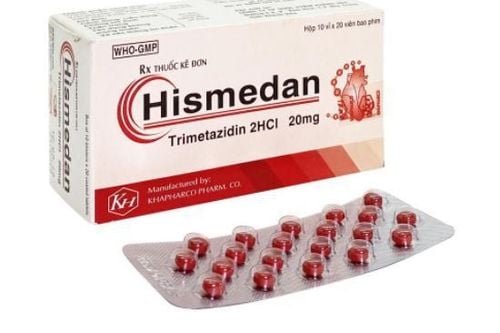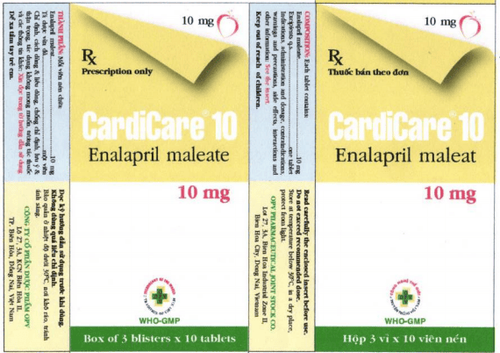This is an automatically translated article.
Verapamil is a nondihydropyridine calcium channel blocker, available in the form of tablets, oral solution and injection. Verapamil is used to treat heart disease. For more detailed information about Verapamil, please read the article below.1. What is Verapamil?
Verapamil contains active ingredient Verapamil with different drug forms and strengths as follows:
Coated tablets with strengths: 40mg, 80mg, 120mg. Extended release tablets with strengths: 120mg, 180mg, 240mg. Oral solution with content: 40mg/5ml. Solution for injection: 5mg/2ml, 10mg/4ml ampoules and 5mg/2ml, 20mg/4ml vials. Mechanism of drug Verapamil:
The drug reduces conduction through the atrioventricular node, slows down the rate of rapid ventricular tachycardia, which often occurs in atrial flutter, atrial fibrillation. The drug dilates coronary and peripheral vessels, and also inhibits coronary artery spasm, thus having antianginal effects. Drugs that reduce peripheral arterial resistance reduce myocardial oxygen consumption and lower blood pressure.
2. What are the effects of Verapamil?
Treatment of essential hypertension. Treatment of stable or unstable angina, Prinzmetal's pain. Treatment of paroxysmal supraventricular tachycardia and prevention. Prophylaxis of secondary myocardial infarction in cases of contraindication or intolerance to beta-adrenergic blocking agents in the absence of heart failure.
3. Dosage of Verapamil
Dosage of Verapamil for adults depends on the severity of the disease and the patient's response.
Treatment of angina:
Usual dose: 80 - 120mg x 3 times/day Extended-release tablets can be used up to a dose of 480 mg/day. Treatment of paroxysmal supraventricular tachycardia and prevention:
Start with a dose of 5 - 1 mg intravenously slowly over 2 - 3 minutes. If necessary, a second dose of 5 mg may be given 5-10 minutes after the first dose, or 10 mg 30 minutes after the first dose. Oral dose: 120 - 480mg/day, divided into 3 - 4 times Treatment of essential hypertension:
Start with dose: 240mg/day, divided into 2 - 3 times. The dose may be increased to 480 mg/day. Prophylaxis of secondary myocardial infarction:
Extended-release tablets, starting 1 week after acute myocardial infarction at a dose of 360 mg/day, divided into several small doses. The dosage of Verapamil for children depends on age and response to the drug.
Intravenous dose for children with supraventricular arrhythmias:
Children under 1 year old: 100 - 200 micrograms/kg. From 1 to 15 years: 100 - 300 micrograms/kg (maximum 5 mg). This dose must be given over at least 2 minutes, if necessary it can be repeated after 30 minutes. If the child has had a good response, the injection should be stopped immediately. Orally for children with supraventricular arrhythmias or hypertension:
Children under 2 years old: 20 mg x 2-3 times/day. Children over 2 years old: 40 - 120 mg x 2 - 3 times/day. Hepatic impairment:
Verapamil is metabolized by the liver and should be used with caution in people with hepatic impairment. Reduce dose by 1⁄3 compared to usual dose for patients with severe hepatic impairment. Patients with renal impairment:
No dose reduction is necessary, even in the case of hemodialysis or peritoneal dialysis.
4. How to use Verapamil?
Tablets are taken orally, usually divided into 3 times a day. Long-acting tablets must be swallowed whole, without chewing. Administer intravenously slowly over at least 2 minutes.
5. Contraindications of Verapamil
Verapamil should not be used in the following cases:
Bradycardia, ventricular tachycardia, decompensated heart failure. Lower blood pressure. Cardiogenic shock, atrial fibrillation, atrial flutter, Wolff - Parkinson - White syndrome, complicated acute myocardial infarction. Left ventricular heart failure, hypertrophic cardiomyopathy. You are allergic to verapamil or any of the other ingredients in the medicine. Intravenous verapamil should not be used concomitantly with beta-adrenergic blockers.
6. Verapamil side effects
Common:
Hypotension, complete atrioventricular block, bradycardia (<50 beats/min). Headache, dizziness, fatigue. Shortness of breath, nausea, constipation. Rash. Uncommon:
Flushed. Second and third degree AV block, orthostatic hypotension. Rare:
Tachycardia, convulsions (with parenteral administration) Erectile dysfunction.
7. Precautions when using Verapamil
Caution is advised when using Verapamil to treat arrhythmias in children because children may be more sensitive to the side effects caused by the drug. Verapamil should not be stopped abruptly as this may worsen angina. There are no studies on the use of Verapamil during pregnancy, so it should only be used when clearly needed. Verapamil is excreted in breast milk, breast-feeding is not recommended while taking the drug. The patient's ability to work while awake may be impaired. Especially in the early stages of treatment, when increasing the dose or when taking with alcohol. Missed dose and treatment:
If you miss a dose, take it as soon as you remember. But if it is almost time for your next dose, skip the missed dose and take your next dose as usual. Do not double the prescribed dose of Verapamil. Overdose and treatment:
Must be monitored continuously for at least 48 hours in hospital. When taking long-acting tablets, symptoms may appear late. Treatment in case of overdose:
Cardiac supportive treatment: Intravenous calcium solution (calcium gluconate 10%), or beta-sympathomimetic stimulation. Use activated charcoal if Verapamil overdose within 1 hour, can be combined with gastric lavage. Hypotension: Place the patient in a supine position, infuse plasma, add calcium intravenously, use Glucagon, Isoprenalin, Dopamine or Noradrenalin. Bradycardia: Treatment with Atropin, Isoprenalin, pacemaker placement. Extrarenal dialysis if Verapamil cannot be eliminated.
8. Verapamil drug interactions
With antiarrhythmic drugs: Cardiogenic shock and asystole have occurred in patients receiving fecainamide during treatment with Verapamil. Verapamil can cause hypotension when patients take quinidine concomitantly. Verapamil may increase blood levels of quinidine. With antibiotics: Acute toxicity of Verapamil has occurred with concomitant use of Ceftriaxone and Clindamycin. Rifampicin reduces the concentration of Verapamil in the blood. With beta-blockers: Oral Verapamil and beta-blockers both reduce cardiac activity, if used in combination should be used with caution. Verapamil increases the concentration of Propranolol, Metoprolol in the blood. With digitalis: after 2-3 weeks of taking Verapamil 240mg, the steady-state concentration of Digitoxin increased to about 35%. Phenobarbital and Phenytoin reduce the effect of verapamil Verapamil inhibits carbamazepine metabolism, increases the concentration of free Carbamazepine in plasma, increased toxicity of Carbamazepine. With benzodiazepines: plasma concentrations of Midazolam are doubled and half-life prolonged when co-administered with Diltiazem or Verapamil. Calcium salts: Verapamil antagonist calcium salts should be administered intravenously to treat side effects of Verapamil. Taking calcium adipinate, Calciferol, and Verapamil may cause recurrent atrial fibrillation in people being treated for atrial fibrillation. Verapamil is used to treat cardiovascular diseases such as high blood pressure, angina pectoris. To take medication safely and effectively, patients need to follow their doctor's advice and closely monitor their symptoms. If you have any questions about Verapamil, contact your doctor right away.




